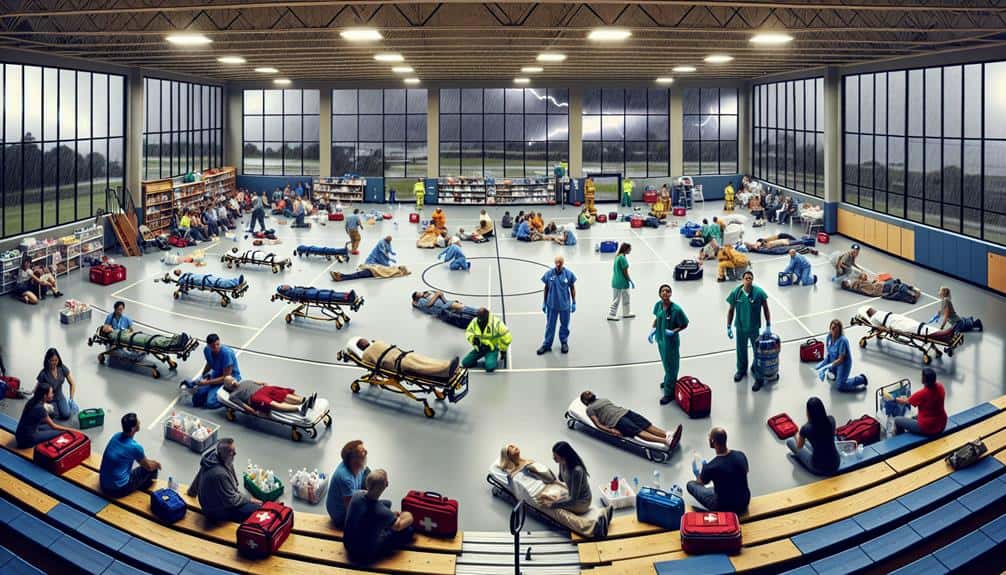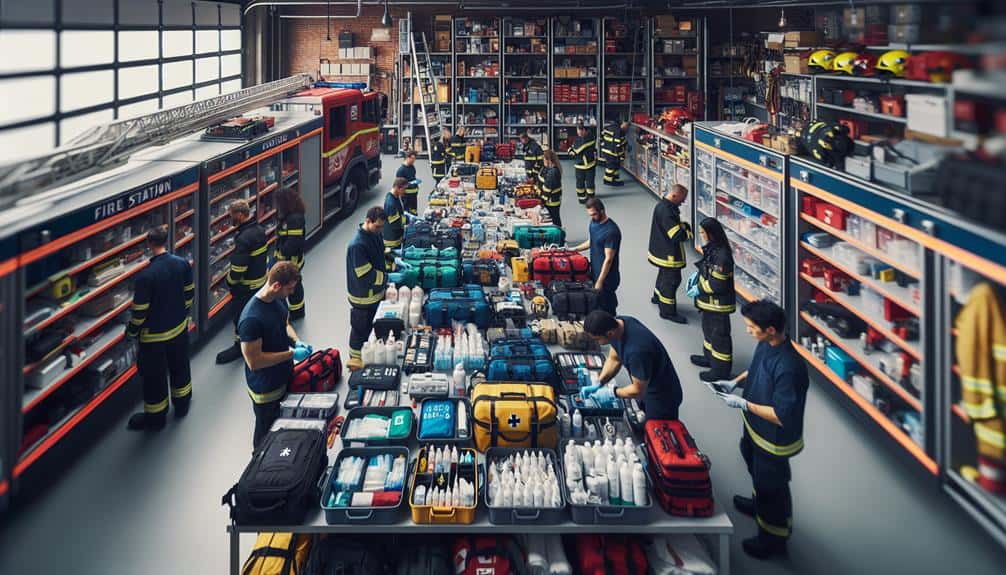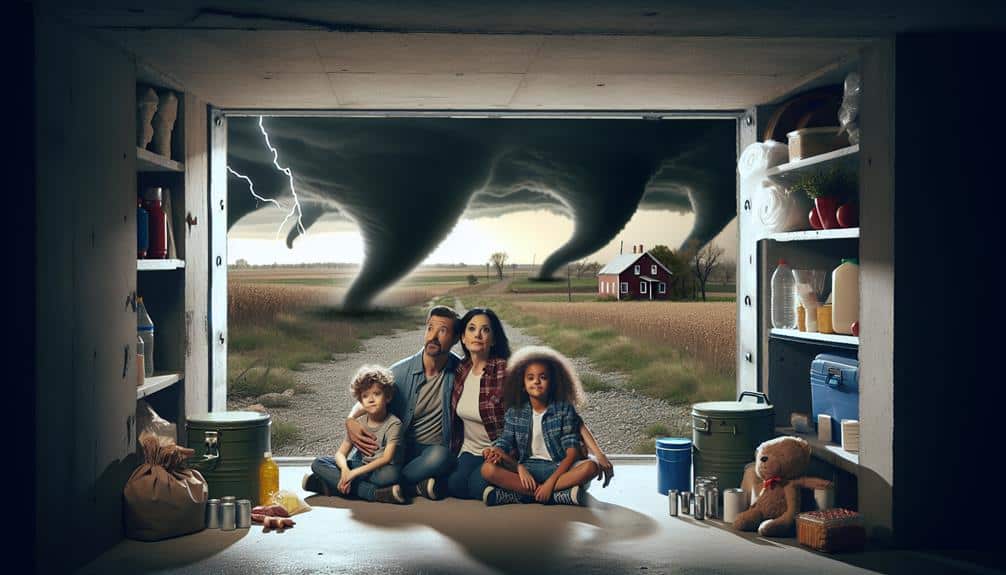We should know that several storm shelter locations, including public emergency shelters, community centers, and schools, typically stock medical supplies to guarantee safety during natural disasters. These locations often have first aid kits, essential medications, and trained medical staff ready to provide immediate assistance. Hospitals and clinics contribute by supplying necessary items, while fire and police stations also make sure shelters are well-equipped. This network plays a pivotal role in maintaining community resilience and self-sufficiency when storms hit. To gain a deeper understanding of the specific contributions and preparations of these shelters, there's a wealth of valuable details to explore.
Key Points
- Public emergency shelters provide first aid kits and necessary medications during natural disasters.
- Community centers employ trained medical staff and well-equipped first aid kits for immediate assistance.
- School storm shelters maintain a stocked inventory of medical supplies and conduct regular drills.
- Fire stations house first aid kits, trauma supplies, and basic medications for storm shelters.
Public Emergency Shelters
Public emergency shelters play a critical role in providing refuge and essential resources during natural disasters. We grasp that when calamities strike, there's no room for error. As such, our commitment to emergency preparedness is non-negotiable.
These shelters offer more than just a roof over our heads; they supply medical resources that can mean the difference between life and death.
Emergency preparedness involves meticulous planning and stocking essential supplies, including first aid kits, medications, and other medical necessities. By making sure that shelters are well-equipped, we can mitigate the impact of disasters on our health and safety.
Our community outreach efforts are equally crucial. We must educate and inform residents about the locations and services of these shelters. This guarantees everyone knows where to go and what to expect before an emergency arises.
Community Centers
At our community centers, we make sure that stocked first aid kits are readily available for anyone in need.
These centers also employ trained medical staff who can provide immediate assistance during emergencies.
Stocked First Aid Kits
Community centers playing a pivotal role in storm preparedness often stock first aid kits equipped to handle a range of medical emergencies. These kits are essential tools for effective emergency response, ensuring that immediate medical needs are addressed when disaster strikes.
By having well-stocked first aid kits, it empowers ourselves and our communities to act swiftly and decisively during critical moments.
In terms of disaster preparedness, these first aid kits typically contain all the essentials: bandages, antiseptics, pain relievers, and basic medical tools. They're designed to treat minor injuries and prevent them from becoming major issues. Community centers recognize that in the chaos of a storm, access to professional medical care might be delayed, so having these supplies on hand is critical.
Moreover, the presence of these kits aligns with a broader strategy of self-sufficiency and resilience. When understanding that our local community centers are prepared, we gain a sense of security and freedom, realizing that we aren't solely reliant on external aid.
This preparedness is a cornerstone of effective emergency response, fortifying our ability to manage and mitigate the impacts of natural disasters.
Trained Medical Staff
We depend on trained medical staff at community centers to provide essential care during emergencies, guaranteeing swift and expert medical intervention when it matters most. These professionals, equipped with thorough medical training, are the backbone of effective emergency care. Their presence in community centers means that we've immediate access to life-saving expertise and interventions.
In times of crisis, having trained medical staff on-site transforms community centers into reliable safe havens. These facilities are more than just shelters; they become hubs of medical support. The personnel are skilled at triaging injuries, administering first aid, and managing medical emergencies until further help arrives. This capability is crucial, as it can mean the difference between life and death.
Our freedom to feel secure in emergency situations is greatly enhanced by the presence of these trained individuals. Their expertise ensures that medical supplies are used efficiently and effectively, maximizing the resources available. In turn, this preparedness alleviates anxiety and empowers us to act confidently during crises.
Hence, investing in medical training for staff at community centers isn't just a precaution but a vital necessity for community resilience and individual freedom.
School Storm Shelters

We must make sure that school storm shelters are easily accessible to students and staff.
Maintaining a detailed inventory of medical supplies within these shelters is essential for effective emergency response.
Additionally, providing emergency response training to school personnel will enhance preparedness and safety.
Accessibility for Students
Securing school storm shelters to ensure accessibility for all students is crucial for their safety in emergencies. We must prioritize student safety and ensure that no one is left behind in times of crisis.
Accessibility in storm shelters goes beyond physical access; it involves creating an inclusive environment where every student, regardless of their abilities, can seek refuge.
Emergency preparedness in schools necessitates a comprehensive approach. This includes having clear evacuation plans that consider students with disabilities. Features like ramps, wide doorways, and Braille signage are essential components of an accessible shelter.
Regular drills should involve all students to ensure that everyone understands their role and can respond promptly during emergencies.
Training is also critical. Staff and students need to be educated on how to assist peers with special needs during emergencies, including the proper use of specialized equipment if required.
Ultimately, the primary goal is straightforward yet essential: to ensure that every student can access the storm shelter comfortably and with dignity. By focusing on accessibility, we bolster our emergency preparedness efforts and strengthen the safety measures protecting our children.
Medical Supplies Inventory
Equally significant to accessibility is maintaining a well-stocked inventory of medical supplies in school storm shelters. We must guarantee that our shelters are equipped with essential items to handle emergencies effectively. A complete medical supplies inventory is a cornerstone of emergency preparedness, enabling us to respond swiftly and efficiently to any situation.
Our supply management strategy should focus on stocking a range of critical items, including first aid kits, disinfectants, bandages, and medications for common ailments and injuries. It's vital that we regularly audit these supplies to make sure they're up-to-date and in good condition. Expired or depleted items must be replenished promptly to maintain readiness.
We also need to take into account special medical needs that students might have, such as EpiPens for severe allergies or insulin for diabetics. By prioritizing these factors, we can create a safer environment for all students during emergencies.
To achieve this level of preparedness, we should establish a clear protocol for inventory checks and updates. This proactive approach guarantees that our storm shelters are consistently equipped to meet the medical needs of our school community. In doing so, we uphold the principles of freedom and security, enabling everyone to feel safe and protected.
Emergency Response Training
Effective emergency response training for school storm shelters is vital to make certain that staff and students know precisely how to act when a crisis occurs. By focusing on thorough emergency preparedness, we guarantee that everyone is equipped with the knowledge and skills needed to handle emergencies. Proper disaster response isn't just about having a plan; it's about practicing that plan until it becomes second nature.
In our schools, we prioritize medical training as part of the emergency preparedness curriculum. This includes basic first aid, CPR, and the use of automated external defibrillators (AEDs). Our goal is to empower staff and students with the ability to provide immediate health services during an emergency. This rapid response can make a significant difference in the outcome of medical situations.
Furthermore, regular drills and simulations help us evaluate and refine our disaster response strategies. By continually evaluating our readiness, we can identify potential weaknesses and address them before a real crisis occurs. This proactive approach guarantees that our school storm shelters aren't just safe havens but also centers of efficient emergency management.
In doing so, we uphold our commitment to safeguarding the well-being and freedom of our school communities.
Hospitals and Clinics
Hospitals and clinics play an important role in providing medical supplies to storm shelters, guaranteeing timely and efficient distribution during emergencies. When disaster strikes, a robust emergency response is essential.
Hospitals and clinics are often the first to mobilize, leveraging their resources and expertise to support storm shelters. Their involvement ensures that important medical supplies, such as first aid kits, medications, and equipment for medical treatment, are readily available.
In our analysis, we see that hospitals and clinics maintain a stockpile of emergency supplies specifically for such crises. They work closely with local storm shelters to identify needs and coordinate logistics. This preemptive planning is pivotal for minimizing delays and guaranteeing that those in shelters receive immediate medical attention.
Furthermore, hospitals and clinics often deploy medical personnel to storm shelters. These professionals provide crucial medical treatment on-site, addressing injuries and illnesses that might arise during a storm. Their presence not only delivers care but also reassures shelter residents, promoting a sense of security and stability.
Fire Stations

Fire stations, like hospitals and clinics, play an important role in guaranteeing storm shelters are equipped with necessary medical supplies. Our fire stations aren't merely hubs for firefighting; they're also instrumental in emergency response and community outreach.
They house vital first aid kits, trauma supplies, and basic medications that can be rapidly deployed to storm shelters when disaster strikes.
By integrating fire stations into the emergency preparedness network, we leverage their strategic locations and 24/7 operational readiness. Firefighters are trained in emergency medical care, making them ideal partners in distributing and managing medical supplies. Their expertise guarantees that storm shelters aren't only stocked but also that supplies are used effectively and efficiently.
Moreover, fire stations are deeply embedded in our communities. Their community outreach programs often include education on emergency preparedness, making them trusted sources of information and assistance. This trust becomes invaluable during a crisis, as people are more likely to seek help and follow guidance from familiar, reliable sources.
Police Stations
Police stations play a crucial role in making sure storm shelters are stocked with essential medical supplies. As hubs of emergency response, they're uniquely positioned to coordinate the distribution of these critical resources. When severe weather hits, our first responders need quick access to medical supplies to address injuries and health issues that arise. Police stations, already central to community safety, become indispensable in this capacity.
We rely on the infrastructure and logistical networks of police stations to streamline the delivery of medical supplies. Their involvement doesn't just stop at distribution; they actively assess needs and make certain that the supplies reach the most affected areas. This proactive approach means that our storm shelters are better prepared, transforming them from mere refuge locations into thorough care centers.
Moreover, police stations are integral community resources. They foster trust and collaboration, which are crucial during crises. By leveraging their established relationships within the community, they can mobilize volunteers and coordinate efforts more effectively. This ensures that medical supplies aren't only available but also efficiently utilized.
Frequently Asked Questions
Are There Any Mobile Storm Shelters That Provide Medical Supplies?
Yes, there are mobile storm shelters that provide medical supplies. Mobile clinics play a pivotal role in emergency response, ensuring quick access to essential care, which empowers communities to remain resilient and maintain their freedom during crises.
Do Private Businesses Offer Storm Shelter Services With Medical Supplies?
Private hospitals and emergency clinics often serve as our lifeboats in a storm, offering shelter services with medical supplies. They anchor us in safety, ensuring we're prepared for any tempest that comes our way.
Can Religious Institutions Provide Storm Shelters With Medical Supplies?
Yes, religious institutions and community centers can provide storm shelters with medical supplies. They often serve as safe havens, equipped to support our community's needs during emergencies, ensuring we maintain our freedom despite adverse conditions.
Are There Any Apps to Locate Storm Shelters With Medical Supplies?
Let's cut to the chase: yes, there are apps that help locate storm shelters with medical supplies. These apps offer emergency response features, detailed shelter mapping, and access to critical medical resources, ensuring we're prepared for anything.
How Can I Verify the Availability of Medical Supplies in a Storm Shelter?
To verify medical equipment and supplies availability in a storm shelter, we should contact local emergency management agencies. They can provide details on emergency medical assistance availability, ensuring we're prepared and informed during critical situations.


